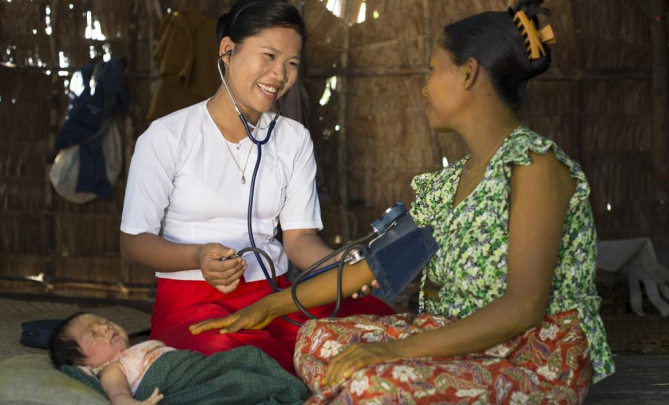Results and Indicators
| Result | Indicator(s) |
| Impact: Women and girls in all their diversity access universal health and fully enjoy their health and sexual and reproductive rights |
SDG 3.7.1 Proportion of women of reproductive age (aged 15–49 years) who have their need for family planning satisfied with modern methods
(Percentage)
Data Source:
Global SDG Indicators Database
https://unstats.un.org/sdgs/indicators/database
Custodian(s): UNICEF
Additional Information:
|
| Result | Indicator(s) |
| Specific Objective - Outcome: Enabled legal, political and societal environment allowing women and girls to access quality sexual and reproductive health (SRHR) care and services and protecting their sexual and reproductive rights |
SDG 5.6.2 Number of countries with laws and regulations that guarantee full and equal access to women and men aged 15 years and older to sexual and reproductive health care, information and education, disaggregated at least by sex (KEY INDICATOR)
(Numeric)
Data Source:
Studies conducted and budgeted annually by the intervention, minimum baseline and endline;
Population-based survey data:Â Demographic and Health Surveys (DHS), Multiple Indicator Cluster Surveys (MICS), VAW specialized surveys (for example those using the WHO methodology), Violence against Children Surveys (VACS), the International Men and Gender Equality Survey (IMAGES) and other national surveys where relevant.
Additional Information:
|
| Result | Indicator(s) |
| Impact: Women and girls in all their diversity access universal health and fully enjoy their health and sexual and reproductive rights |
SDG 3.7.2 Adolescent birth rate (aged 10–14 years; aged 15–19 years) per 1,000 women in that age group
(Percentage)
Data Source:
Studies conducted and budgeted annually by the intervention, minimum baseline and endline
Additional Information:
|
SDG 3.1.2 Proportion of births attended by skilled health personnel
(Percentage)
Data Source:
Surveys commissioned and budgeted by the intervention, minimum baseline and endline
Population survey data on FGM:Â Demographic and Health Surveys, MICS and other nationally representative surveys.
Additional Information:
Proportion of births attended by skilled health personnel
|
| Result | Indicator(s) |
| Impact: To reduce malnutrition in all its forms, and in particular among children, adolescent girls and women of reproductive age |
Prevalence of undernourishment (SDG 2.1.1), disaggregated at least by sex
(Numeric)
Data Source:
Global SDG indicators database, https://unstats.un.org/sdgs/dataportal Baseline and endline studies conducted and budgeted by the intervention.
Additional Information:
Also included under thematic area of engagement Promoting economic and social rights and empowering girls and women. For specific thematic objective and indicators on this impact indicator please see "thematic area of engagement: Promoting economic and social rights and empowering girls and women", thematic objective 10. |
| Result | Indicator(s) |
| Specific Objective - Outcome: Enabled legal, political and societal environment allowing women and girls to access quality sexual and reproductive health (SRHR) care and services and protecting their sexual and reproductive rights |
Extent to which SRHR-sensitive policies, strategies and programmes introduced by partner government on: a) ending harmful practices e.g. child marriage and female genital mutilation; b) adolescent SRHR; c) comprehensive sexuality education; d) family planning; e) removal of third parties consent for contraception; f) control of sexually transmitted infections including HIV and AIDS; g) cancer screening (Other non-key indicator)
(Qualitative)
Data Source:
Surveys conducted and budgeted by the intervention, minimum baseline and endline
Additional Information:
To check the methodological notes for this indicator please click on srhr_fiche_other_outcome_indicator_1.1.pdf
|
Extent to which the gender equality policy or similar for sexual and reproductive health care and services is implemented (Other non-key indicator)
(Qualitative)
Data Source:
Annual surveys conducted and budgeted by the intervention, minimum baseline and endline
Additional Information:
To check the methodological notes for this indicator please click on srhr_fiche_other_outcome_indicator_1.2.pdf
|
|
Extent to which the gender equality policy or similar for sexual and reproductive health care and services is monitored and evaluated (Other non-key indicator)
(Qualitative)
Data Source:
Annual studies/media analysis, conducted and budgeted by the intervention
Additional Information:
|
|
Extent to which communities stigmatize women and girls with SRHR problems (Other non-key indicator)
(Qualitative)
Data Source:
Annual studies/media analysis, conducted and budgeted by the intervention
Additional Information:
To check the methodological notes for this indicator please click on srhr_fiche_other_outcome_indicator_1.4.pdf
|
|
Number of men and boys engaging in government or civil society SRHR actions (Other non-key indicator)
(Numeric)
Data Source:
Annual studies/media analysis, conducted and budgeted by the intervention
Additional Information:
To check the methodological notes for this indicator please click on srhr_fiche_other_outcome_indicator_1.5.pdf
|
